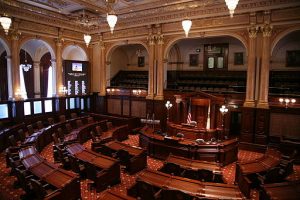A state lawmaker wants to limit the number of students in every Chicago Public School classroom, but she could be facing an uphill battle.
State Sen. Kimberly Lightford (D-Maywood), vice-chairperson of the Education Committee, has proposed a law that would force Chicago schools to cap classroom sizes. But, Lightford admits she doesn’t know how she would pay for the initiative.

The Chicago Teacher’s Union says class sizes are too large system-wide, and in a recent study they found as many as 42 students in at least one elementary school classroom.
A 2011 analysis from the Chicago Teacher’s Union found that Chicago Public Schools is now at about 25 students per class at the high school level, which is larger than 99 percent of 504 other Illinois school districts. The study also says there is an average of about 24 students in Chicago kindergarten classrooms. That’s larger than 95 percent of Illinois’ school districts.
Lightford has sponsored SB 3362, which limits the maximum number of students assigned to each teacher: pre-kindergarten through grade three classrooms may not exceed 18 students; grades four through eight cannot have more than 22 students in one classroom and grades nine through 12 may not exceed 25 students per classroom.
“I don’t know how any of our education initiatives are going to be funded at this point but (classroom size) is something I think we should consider a main concern as we prioritize our budget,” said Lightford in an interview.
Lightford said she recognizes the budget problems Chicago’s 675 schools face: the 2011-2012 year began with a $712 million deficit, and a retracted 4 percent pay-raise for teachers.
But funding for improving classroom size is for the administration to figure out, she said.
The Chicago Teacher’s Unions and Chicago Public Schools’ Board of Education need to sit down and collaborate on what’s best for the students, and reducing classroom size needs to be a part of that discussion, she said. “I think they’re intelligent enough.”
Lightford said she has been in contact with members of the Chicago Teacher’s Union and Chicago Public Schools’ administrations and has suggested starting a pilot program, targeting 25 schools that have problematic classroom sizes. She would not indicate which representatives she has spoken with.
One other state lawmaker, Sen. David Luechtefeld (R- Okawville), who taught for several decades at Okawville High School and also serves on the Education Committee said the bill was “too much to ask for” and questioned the timing of Lightford’s legislation.
“I don’t deny that a smaller class size is a plus and we should shoot for that, but if schools can’t pay for what they’re doing right now, how are they supposed to pay for more teachers and more classes?” he said. Luechtefeld said he managed high school history and government classrooms that often held between 25 and 32 kids.
One advocacy group thinks that Chicago Public Schools is misusing the money it has. Leonie Haimson, founder and executive director of Class Size Matters said two initiatives, merit pay and turnaround consultants, were a “waste of money” and should have taken a backseat to reducing class room size.
“Smaller classes allow teachers to give individualized help and respond to students’ questions while giving them ability to engage in discussion and debate,” she said. Class Size Matters is a non-profit group that advocates for smaller classes in New York City and the nation, and provides information on the benefits of smaller classes.
“We should be investing every penny in the classroom to improve learning for kids and, in fact, the opposite is happening across the country,” she said.
Undergoing contract negotiations, the Chicago Teacher’s Union presented a detailed reform plan on Feb. 16, with a price tag of $713 million, calling for the cap in kindergarten through third grade classrooms to drop from 28 to 20 students. The organization estimates that it would cost about $170 million to lower class sizes in Chicago Public Schools’ elementary classrooms.
Lightford’s bill would impose “civil penalties” on school districts that could not adhere to the reduction in class sizes. She said she doesn’t know if she “loves” that portion. She would only elaborate on the language of “civil penalties” by referring to them as “small repercussions.”
“We wanted to put some penalties in place so that (Chicago Public Schools) would respond to the actual law because there is a non-trust issue,” she said.
Representatives from Chicago Public Schools and the Chicago Teacher’s Union could not be reached for comment.












Be First to Comment